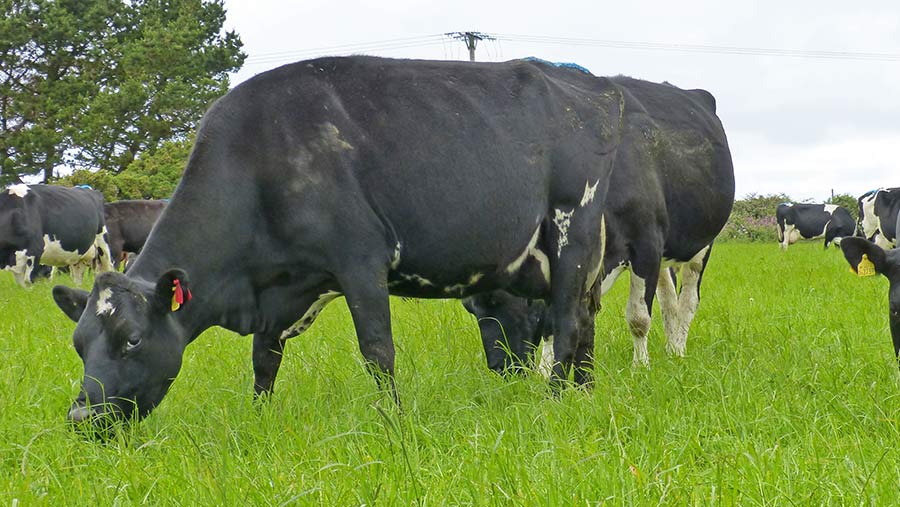How to set your grazing up for next spring

Planning is vital to ensure good grass covers and an early turnout next spring.
Every day spent spring grazing is worth twice as much profit as a day in the autumn.
Below, Bess Jowsey, pasture to profit consultant of genetics firm LIC (Livestock Improvement Company), offers advice for dairy farms on how to manage grassland for the remainder of the summer.
See also: Guide to setting up a grazing infrastructure
Key points
- Switch to a maximum of 48 hours on each paddock to avoid grazing regrowth.
- Plan your last grazing rotation in August to build covers for winter and spring 2020.
- Produce an autumn grass budget, now based on average farm cover (AFC) (see graph).
1 Switch to a maximum of 48-hour shifts
Whether farms are measuring grass or not, all rotational grazing systems should be moving cows to new paddocks at least every 48 hours.
Speaking at an Agriculture and Horticulture Development Board (AHDB) meeting in Blubberhouses, North Yorkshire last week (31 July), Ms Jowsey said short shifts were vital to avoid the first leaf being nipped off at a time when regrowth was rapid.
Latest AHDB dairy grass growth data showed average late July daily grass growth was 62.9kgDM/ha. This is 3.9kg ahead of 2017 and 41.67kg ahead of last year.
2 Plan your last grazing rotation to build covers
Ms Jowsey said the best way to manage grass well into the winter and ensure good grass covers in the spring was to increase rotation length and overall farm covers.
Farms build covers in the autumn through:
- Natural autumn growth – warm, wet conditions, grasses are past their flowering/seeding stage and stems are soft and more palatable.
- Introducing more grazing area: Silage land may come back into the rotation
- Extending the length of their grazing round.
How to build autumn grass cover:
- Note down your target housing date when cows are inside all day based on conditions and farm history, for example 15 November
- Then work back 45 days if you are an autumn calver or 60 days if you are a spring calver to figure out when your last rotation should start, in this case 2 October for an autumn calver or 16 September for a spring calver.
- Start lengthening your 21-day rotation in August to build up average farm cover to extend the grazing season into winter.
- Extend your 21-day summer rotation to 45-day rotation by the start of the last grazing rotation, either 60 or 45 days ahead of winter housing. For instance, on a 40ha autumn calving grazing platform, there will be a daily allocation of 1.9ha/day on a 21-day rotation (40 divided by 21 = 1.9), which needs to be extended with smaller paddocks of 0.9ha (40 divided by 45 = 0.88ha) with electric fencing.
- Enter paddocks at the standard 2,700-2,900kg DM/ha (2.5-3-leaf) throughout August and leave a 1,500kg DM/ha residual.
- As covers build, expect to enter stronger paddocks in August and September (up to 3,600kg DM/ha).
- Start the last grazing round at an AFC of 2,500-2,600kg DM/ha and end the grazing season at a minimum AFC of 2,100kg DM/ha.
- Then, as housing date approaches, review your grazing budget (step 3) to figure out demand and silage/concentrate/housing requirements.
3 How to produce an autumn grass budget
To produce a grass budget this month, you need the following information:
- Grazing platform area: for example, 28ha
- Monthly milking, dry cow and youngstock numbers: 90-120 milkers, 0-30 dry cows and 0 youngstock.
- Feed rate and daily grass demand: for example, 4.5kg of parlour cake, increasing to 6kg. Milking cows eating 14kg, 12kg and then 8kg of grass DM/day with dry cows eating 12kg DM.
- Typical average monthly grass growth rates: Farm pasture data or AHDB Forage for Knowledge data.
Farm example
The example in the table is of a hypothetical 120-cow, autumn block calving herd on a 28ha grazing platform.
Demand is calculated by multiplying average daily demand by the number of cows and dividing that by the number of hectares on the platform. For example, September milking cow demand is 14kg x 100 cows = 1,400kg divided by 28ha = 50kg/ha).
Calculating demand |
||||
|
|
August |
September |
October |
November |
|
Milking cow numbers |
90 |
100 |
115 |
120 |
|
Grass DM intake a cow/day |
14kg (4.5kg of parlour cake) |
12.5kg (6kg of parlour cake) |
12 (6kg of parlour cake and only 8kg of grass plus silage if night time housing) |
8kg (6kg of parlour cake and silage) |
|
Milking cow demand/ha |
45 |
45 |
33 |
26 |
|
Dry cow demand/ha |
13 |
8.5 |
8 |
0 |
|
Youngstock demand |
0 |
0 |
0 |
0 |
|
Total demand/ha |
58 |
62 |
51 |
34 |
|
Growth rate |
65 |
52 |
26 |
5 |
|
Difference between growth and demand/month |
+217 |
-45 |
-450 |
-210 |
|
AFC cover |
2,517 |
2,472 |
2,022 |
1,812 |
Consultant prognosis
Ms Jowsey says: “This current budget suggests the cows may need housing at night in October as the average farm cover must be maintained above 2,100kg to allow for a timely turnout in the spring.
“November’s AFC is dangerously low and short of the 2,100kg DM/ha we need.
“However, this all could change if some extra area is added to the 28ha and/or the autumn growth could be better than predicted, which is why it’s important to reassess each month.”
